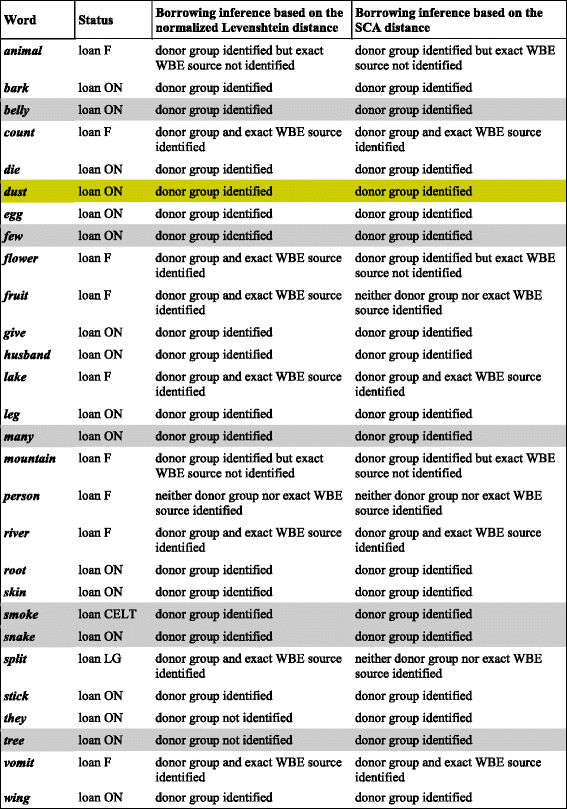
- Cases of confirmed borrowing, according to Donohue et al. [22] are not colored; cases of possible borrowing, which could have been unrecognized according to List et al. [21], are shaded in gray (note that List and colleagues point out that the grayed words can also represent cases of parallel semantic development [21]); an additional suggestive case of borrowing (i.e., dust) is in yellow. When the Old North (ON) group was assumed to be the word donor, the exact source of borrowing in the ON group was not considered since it remains unknown in most of these cases. The Neighbor-Joining algorithm [51] was carried out to reconstruct phylogenies from distance matrices. Here, we considered all of the confirmed or suggested loanwords of the basic English vocabulary associated with the 200-word Swadesh list. The loanword information was taken from the studies of Donohue et al. ([22]; Supplementary Material) and List et al. ([21]; modified MLN approach). To the 33 English loanwords identified by Donohue et al. [22] and 8 possible additional English borrowings suggested by List et al. ([21]; Supplementary Material II; Table C), we added the word dust, which might have been borrowed by English from Old North according to the results given by our algorithm for detecting word borrowing events [29]. This English word was also identified as belonging to an irregular pattern, which may be suggestive of borrowing, by the modified MLN approach [21]. To compare the results yielded by the normalized Levenshtein distance [31] and the SCA phonetic distance [58], we examined 28 of the 42 above-mentioned cases of borrowing into English, i.e., all the cases for which at least four cognate phonological forms were available in the IELex database (see http://ielex.mpi.nl [49] for the cognate sets that included the considered English word forms). Thus, 28 of 42 suggested English borrowings (see the table) were examined along with their donor word form and all of the donor’s cognates that had phonological entries in IELex (the data were taken in September 2015). The detailed results have been included in the archive file Biolinguistic_networks_data.zip available at: http://www.trex.uqam.ca/biolinguistics. This data archive comprises word tree representations, lexeme and phonological distance matrices, and the Perl script for computing the normalised Levenshtein distance
-
Abbreviations: F French, ON Old North, CELT Celtic group, WBE word borrowing event
